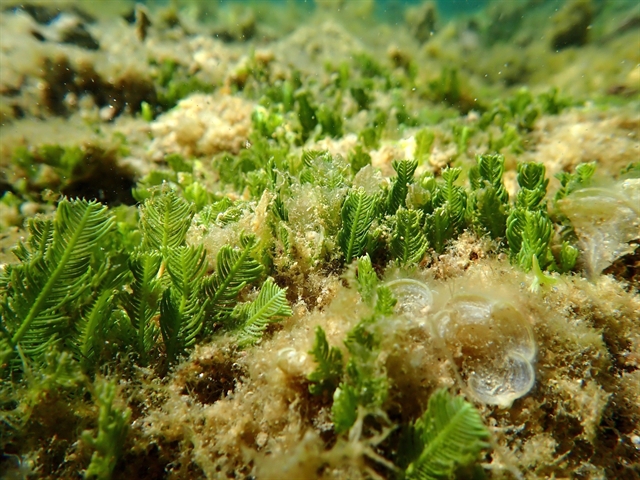
|
| Seaweed and seagrass ecosystem in Núi Chúa National Park’s Marine Protected Area in Ninh Hải District, the coastal south-central province of Ninh Thuận.—VNA/VNS Photo |
HÀ NỘI — Scientists from the Institute of Biotechnology under Việt Nam Academy of Science and Technology have successfully developed 69 extracts from 11 species, belonging to eight genera of seaweed for dietary use in Alzheimer’s treatment.
The achievement stems from the project ‘Neuroprotective effects against Alzheimer’s disease by some Vietnamese seaweed species’.
Within the scope of their research, seaweed from the eight genera, Ulva, Kappaphycus, Sargassum, Eucheuma, Gracilariopsis, Caulerpa, Gracilaria and Palzheimerina were examined.
Significantly, for the first time, the molecular mechanisms of action of fucoxanthin (a natural compound derived from brown seaweed) isolated from S. oligocystum (a widespread species in many Asian and American coastal regions) and ethanol extracts from Sargassum spp. (a genus of floating seaweed in the Sargassaceae family) were studied.
The compounds were found to possess antioxidant properties, inhibit AChE (acetylcholinesterase) and protect against cellular toxicity in an Alzheimer’s-induced model using H2O2 on C6 nerve cell lines.
Professor Đặng Diễm Hồng, the project leader, said that the research demonstrated that fucoxanthin extracted from S. oligocystum and 96 per cent ethanol extract (with ultrasound) from Sargassum spp. are safe regarding acute and sub-chronic toxicity and can improve cognitive decline caused by scopolamine (similar to donepezil at a dose of 5 mg/kg body weight in mice) in experimental animal models.
The research team has published two scientific papers in international SCI-E indexed journals, one paper in a national journal (VAST02), presented one report at the ISS2023 international conference, and delivered a full paper at the 2022 National Biotechnology Conference.
The project received excellent evaluation and classification from the Việt Nam Academy of Science and Technology.
With these promising results, Hồng hoped that the research project could continue and be tested to refine the natural, nutrient-rich health-protective products.
“The endeavour aims to contribute effectively to the treatment of Alzheimer’s patients and those working under strenuous conditions in Việt Nam in the near future,” she said.
Việt Nam has its extensive coastline spanning 3,260km and abundant biodiversity in both marine and non-marine resources.

|
| A fisherman gathers seaweed in the waters of Nhơn Hải Commune, Ninh Hải District, the coastal south-central province of Ninh Thuận.—VNA/VNS Photo Nguyễn Thành |
The country has documented 878 seaweed species, consisting of 439 species of red algae (Rhodophyta), 196 green algae (Chlorophyta), 156 brown algae (Ochrophyta-Phaeophyceae), 87 cyanobacteria (Cyanophyta) and 15 seagrass species.
Genera such as Caulerpa, Sargassum, Gracilaria, Ulva, Kappaphycus and Eucheuma are economically important seaweed genera with substantial natural cultivation and extraction capabilities, yielding high outputs.
They provide a rich source of natural ingredients, suitable for food use and extraction of biologically active compounds, including those with neuroprotective effects and memory enhancement for humans.
Alzheimer’s disease
Alzheimer’s disease is one of the most common causes of memory decline in the elderly, typically appearing between the ages of 50 to 65.
It is characterised by the progressive loss of nerve cells and certain brain regions.
The disease tends to worsen over time, impacting daily activities, memory, language and cognitive functions of patients.
According to the academy, the number of Alzheimer’s patients is expected to exceed 100 million by 2050.
Currently, there is no complete cure for the disease, while treatments mainly focus on early detection and prevention.
Prescription drugs used in the treatment and management of Alzheimer’s (such as rasagline, rivastigmine and donepezil) are primarily related to inhibiting cholinesterase and β-secretase (BACE-1) enzymes, or inhibiting the N-methyl-D-aspartate (NMDA) receptor with memantine.
However, these drugs can have side effects such as nausea, vomiting, dizziness, liver toxicity and gastrointestinal disorders.
Consequently, a promising future treatment direction is the use of natural products rich in nutrients, with neuroprotective activity and fewer or no side effects compared to synthetic drugs.— VNS
- Reduce Hair Loss with PURA D’OR Gold Label Shampoo
- Castor Oil Has Made a “Huge” Difference With Hair and Brow Growth
- Excessive hair loss in men: Signs of illness that cannot be subjective
- Dịch Vụ SEO Website ở Los Angeles, CA: đưa trang web doanh nghiệp bạn lên top Google
- Nails Salon Sierra Madre
 VnExpress News The News Gateway of Vietnam
VnExpress News The News Gateway of Vietnam





